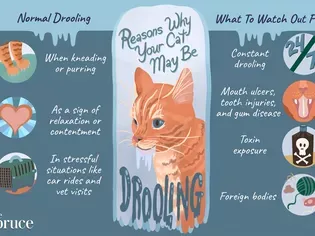Cat Drooling: When It's Normal and When Something's Wrong
Updated on 04/26/24

Cat Drooling: When It's Normal and When Something's Wrong
Cats, like humans, produce saliva to aid in digestion, lubricate the mouth, and protect against bacteria. However, excessive drooling, known as hypersalivation, can be a sign of underlying health issues. This comprehensive guide will delve into the nuances of cat drooling, helping you distinguish between normal and concerning scenarios.
Normal Cat Drooling
* During Grooming: As cats meticulously groom themselves, they ingest loose fur and debris, which can stimulate saliva production.
* After Eating: Drooling can occur after a satisfying meal, as cats swallow excess saliva along with the food.
* Dental Care: Brushing your cat's teeth or administering dental treats can trigger temporary drooling.
* Nausea: Some cats may drool in anticipation of vomiting. However, this should be infrequent and accompanied by other symptoms of nausea, such as lethargy or reduced appetite.
* Motion Sickness: Similar to humans, some cats experience car sickness, which can manifest as drooling.
When Drooling Becomes a Concern
While occasional drooling is normal, excessive or persistent drooling can indicate a medical problem:
Oral Health Issues:
* Dental Disease: Inflamed gums (gingivitis) or dental abscesses can cause severe pain and drooling.
* Tooth Fractures: A broken or cracked tooth can expose the nerve, leading to pain and increased saliva production.
* Stomatitis: An inflammation of the oral mucosa can cause drooling, difficulty eating, and pain.
Gastrointestinal Problems:
* Nausea and Vomiting: Severe nausea and vomiting can lead to dehydration and excessive drooling.
* Gastritis: Inflammation of the stomach lining can cause stomach upset, including drooling.
* Intestinal Obstruction: A foreign object or other obstruction in the digestive tract can block food and液体的passage, resulting in drooling and vomiting.
Other Medical Conditions:
* Rabies: This fatal viral infection affects the central nervous system, leading to a variety of symptoms, including excessive drooling.
* Toxins: Ingesting poisonous substances can cause a range of symptoms, including drooling, vomiting, and seizures.
* Liver Disease: Liver dysfunction can lead to the accumulation of toxins in the body, resulting in drooling and other symptoms.
* Kidney Disease: Advanced kidney disease can alter fluid balance in the body, causing increased saliva production.
What to Do if Your Cat Is Drooling
If your cat is drooling excessively or persistently, it's crucial to consult your veterinarian promptly. The underlying cause can be determined through a physical examination, blood tests, and other diagnostic procedures.
Treatment for Cat Drooling
The treatment for cat drooling will depend on the underlying cause:
* Oral Health Issues: Dental cleaning, antibiotics, or tooth extraction may be necessary.
* Gastrointestinal Problems: Medication or surgery may be required to address nausea, vomiting, or intestinal obstructions.
* Other Medical Conditions: Specific treatments will vary depending on the diagnosis.
Conclusion
Cat drooling can provide valuable insights into your pet's health. While occasional drooling is normal, excessive or persistent drooling can be a sign of underlying medical issues. If you notice your cat drooling excessively, don't hesitate to contact your veterinarian for a thorough evaluation and appropriate treatment. Remember, early diagnosis and intervention can significantly improve your cat's health and well-being.
Explore More Pets

Cat Behavior Problems
How to Stop Aggression in Kittens

Long-Haired Cat Breeds
Siberian Cat: Breed Profile, Characteristics, & Care

Cat Behavior Problems
How to Stop Kittens From Scratching and Biting

Long-Haired Cat Breeds
Turkish Angora: Cat Breed Profile, Characteristics & Care

Basic Training
How to Socialize Your Kitten

Short-Haired Cat Breeds
Cute Pictures & Facts About Calico Cats & Kittens

Litter Box Training
Training Your Kitten to Use the Litter Box

Long-Haired Cat Breeds
10 Fun Facts About White Cats